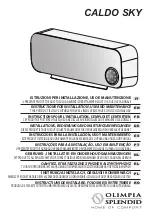
20
O
PERATION
ENVIRONMENTAL AWARENESS
When driving the vehicle, be careful of potential environmental hazards like steep
slopes, rocks, tree branches, etc. that could cause an incident that could result in vehicle
damage, personal injury or death.
There is a risk of fire when the vehicle is operated near combustible material.
Always be respectful of the environment.
Respect all wildlife and their habitat.
Respect private property and comply with all local laws and regulations governing the use of light duty utility vehicles.
Make sure you are permitted by property owners to operate the vehicle on their property.
If operating the vehicle on private property, obtain permission from the owner prior to entering their property.
BATTERY CHARGER
The charger should be operated in accordance with the charger manufacturer’s instructions. Always place the charger
outside the vehicle before and during the charging cycle. Never charge batteries in a hazardous environment.
Risk of electric shock. Connect the charger power cord to an outlet that is correctly
installed and connected to an electrical ground according to all codes and regulations. A
grounded outlet is necessary to decrease the risk of electric shock – do not use ground
adapters or replace the plug. Do not touch parts of output connector or battery terminals
that do not have insulation.
Disconnect the AC plug before you make or break the connections to a battery that is
charging. Do not open or disassemble the charger. Do not operate the charger if the AC
cord is damaged. Make sure qualified personnel does all repair work to the charger.
To prevent over-heating that can cause damage to the charger and possible fire, keep the
air fins clear.
The power AC cord has a plug with a ground post. Do not remove, cut, or bend the
ground post.
The off board or portable charger must have a dedicated 15 amp AC circuit, refer to the charger manual for appropri
-
ate circuit protection. The charger should be placed in an area that permits good air flow around and under the char
-
ger Read and follow the operation instructions supplied by the manufacturer with the charger. Before charging the
batteries, park the vehicle in a well ventilated area, engage the parking brake, turn the key switch to the OFF position,
and remove the key. Connect the AC cord to a dedicated 15 amp AC outlet to activate the charger. Plug the charger
cord into the charge receptacle on the vehicle. Unplug and properly store the cord when the charging cycle is com
-
plete.
PERFORMANCE FEATURES
NOTICE: The speed of the motor is sensed and controlled by the controller.
Speed Control
The speed control system is not an alternative for the brake. Use the brake to control
speed and decrease the risk of injury.
Speed control system vehicles are equipped with a regenerative motor control system.
Example: If all of the following events occur:
• the vehicle is being driven down a slope
• the vehicle attempts to exceed the specified top speed with the accelerator pedal pressed
or
released
the regenerative brake will limit the speed of the vehicle to the specified top speed but the warning beeper will
not
activate. When the regenerative braking system is activated by this sequence of occurrences, the motor generates
power which is returned to the batteries.
If the operator tries to override the electronic brake feature by moving the direction selector or key switch to another
position the vehicle will brake
quickly
until it reaches approximately 2 mph (3 kph).
Summary of Contents for Valor
Page 1: ...10008970 A ISSUED MAR 2020 OWNER S MANUAL Valor 48V ...
Page 8: ...6 TABLE OF CONTENTS ...
Page 12: ...10 SAFETY ...
Page 18: ...16 SAFETY ...
Page 28: ...26 OPERATION ...
Page 50: ...48 MAINTENANCE LOG DATE MILES KM AND HOURS TECHNICIAN SERVICE PERFORMED COMMENTS ...
Page 51: ...MAINTENANCE LOG 49 DATE MILES KM AND HOURS TECHNICIAN SERVICE PERFORMED COMMENTS ...
Page 52: ...50 MAINTENANCE LOG DATE MILES KM AND HOURS TECHNICIAN SERVICE PERFORMED COMMENTS ...
















































